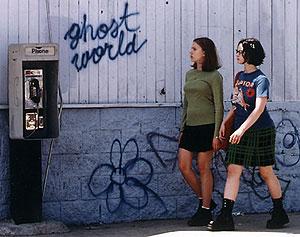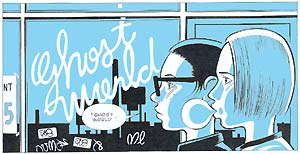
UNITED ARTISTS FILMS
Scarlett Johansson and Thora Birch play Rebecca and Enid in 'Ghost World' |
"Ghost World," the movie, keeps the same premise as the book. Two best-friends, Enid (Thora Birch) and Rebecca (Scarlett Johansson), just graduated from high school, share a private universe of weirdness. Unfunny comedians, Indian rock and roll music of the sixties, abandoned pants on a sidewalk: anything uncoopted by the corporate American monoculture becomes an object of worship. They gripe about having no sex because all the boys are intolerably interested in sports or guitars and amuse themselves by obsessively following weirdoes around their homogenous, suburban neighborhood. But slowly the relationship becomes strained as Enid befriends Seymour (Steve Buscemi), a lonely collector of antique ephemera, and Rebecca yearns to put her life in some sort of direction.
Thora Birch, with her black bobbed hair and constantly changing "look," embodies the cartoon Enid so closely it almost feels embarrassing-- like seeing someone you know on the screen. Fans of the Clowes original will want the audience to like her even if she's kind of obnoxious and opinionated. Johansson likewise perfectly matches the blonde, more reserved Rebecca. And though his character doesn't exist in the original comic, Buscemi's self-hating, nerdish record collector Seymour could easily have stepped out of its pages.
 Enid and Rebecca in the original 'Ghost World'
Enid and Rebecca in the original 'Ghost World' |
The only disappointment readers of the comic may feel is that director and co-writer Terry Zwigoff (who last did "Crumb," about the underground comix master) turns the focus of the movie more on Enid and her emerging relationship with Seymour rather than the girls' friendship. The book enjoys its reputation primarily for the uncanny naturalness and intimacy of the two girls' banter as they constantly affirm each other with "I know," or refer to each other's past history with questions like "Isn't that the thing David Lipton gave you in the fifth grade?" Much of the book's dialogue has been transferred verbatim but the movie turns the dissolution of this friendship into just one of several disappointments in Enid's life. Fortunately the chemistry between Enid and Seymour has enough of a charge to almost make up for the shift in focus.
Likewise, Zwigoff has changed the look of "Ghost World" from a slate-blue monochrome to full color. While this sacrifices the melancholy, "ghostly" tone of the comic, it also allows for sharper contrasts between the garish, fluorescent world of fake fifties diners and multiplexes vs. the velvety tones of Enid and Seymour's cluttered bedrooms. Director of photography Affonso Beato makes the most of highlighting how ghastly America's commercial spaces and their inhabitants have become. "Look at all these creeps," Enid squeals with delight as she enters the sunless world of an "adult" videostore.
But most importantly the Clowes sensibility has successfully made it into movie theaters. It's too bad that it takes a movie to expose vast numbers of people to Clowes' pessimistic universe of the lummoxes, schlubs, and dorks who made the Wendy's foodchain possible and who write "comix" review columns on "the web." Some may even wonder if by making a film the creators are implicitly entering the very universe of mass-cult they rail against in the picture. Fear not. Unlike those shrill, hard-sell teen comedies on the other screens, "Ghost World" never becomes the kind of empty, defensive snark-fest that it targets. Clowes and Zwigoff keep the organic pace of the original, and its empathic exploration of painfully changing relationships.
For those unfamiliar with Clowes, watching "Ghost World" will be as divisive as reading the book. Some will "get it," falling in love with a picture that has alienation and savage cultural ridicule wrapped around a sincere emotional center. Others will exit the theater feeling mystified and vaguely insulted, thinking something like, "Were they making fun of Blockbuster Video?"
"Ghost World," the movie, opens today in New York, L.A. and Seattle, and in wider release on August 3. "Ghost World," the comix series, has been collected into paperback and should be available at even second-rate comicbook stores, and regular bookstores.
Tips for hipsters
- The last movie with any sort of non-superhero, "underground" comix origin seems to be "Nine Lives of Fritz the Cat," a 1974 sequel to "Fritz the Cat," based on the Robert Crumb character. Am I wrong? Write me
- Watch for Clowes' artwork making a cameo in Seymour's "Cook's Chicken Inn" scrapbook as well as a masterfully saccharine unicorn in an art display.
- Similarly, Robert Crumb's daughter, Sophie, contributed all of Enid's drawings.
- Lastly, stick through the end credits for an alternate Seymour scene.
